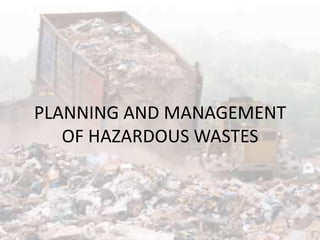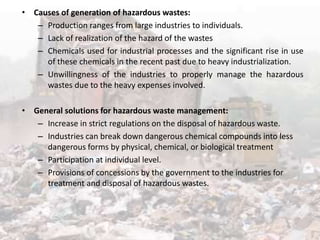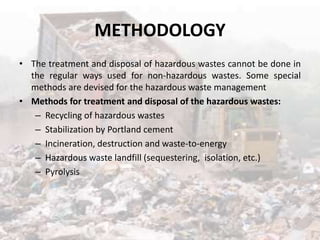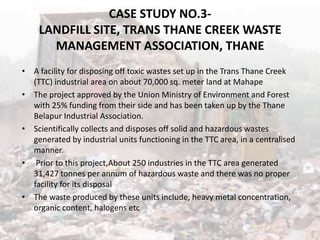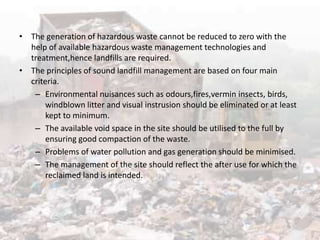Planning and management of hazardous wastes
- 1. PLANNING AND MANAGEMENT OF HAZARDOUS WASTES
- 2. INTRODUCTION • Definition-waste that poses substantial or potential threats to public health or the environment is known as hazardous wastes. • Classification of hazardous wastes: 1. Characteristic hazardous wastes:  Ignitable (flammable)  Reactive  Corrosive  Toxic. 2. Listed hazardous wastes:  non-specific sources  specific sources.  discarded chemical products.
- 4. • Causes of generation of hazardous wastes: – Production ranges from large industries to individuals. – Lack of realization of the hazard of the wastes – Chemicals used for industrial processes and the significant rise in use of these chemicals in the recent past due to heavy industrialization. – Unwillingness of the industries to properly manage the hazardous wastes due to the heavy expenses involved. • General solutions for hazardous waste management: – Increase in strict regulations on the disposal of hazardous waste. – Industries can break down dangerous chemical compounds into less dangerous forms by physical, chemical, or biological treatment – Participation at individual level. – Provisions of concessions by the government to the industries for treatment and disposal of hazardous wastes.
- 5. • Effects of hazardous wastes: – Soluble nitrates from manure may dissolve into groundwater and contaminate drinking-water wells. – Insulation material on furnace pipes contain asbestos particles, which can break off and hang suspended in air; when inhaled, they can cause lung disease and cancer. – Toxic substances that do not break down or bind tightly to the soil may be taken up by growing plants – If rivers and lakes are polluted and become toxic enough, they may kill animal and plant life immediately – Evaporation of toxic solvents from paints and cleaning agents is a common problem causing serious air pollution issues for nearby residents. Effects on animals Paints and other hazardous chemicals
- 7. AIM AND OBJECTIVES • AIM: – To study the planning, design of current systems of management of hazardous wastes viz. – Generation of hazardous waste at source. – reduction of hazardous waste at source. – Transport of hazardous wastes. – Treatment and recovery of hazardous wastes. – Final Disposal of the hazardous wastes. • OBJECTIVE: – To give recommendations for the improvement and modification of these systems.
- 8. METHODOLOGY • The treatment and disposal of hazardous wastes cannot be done in the regular ways used for non-hazardous wastes. Some special methods are devised for the hazardous waste management • Methods for treatment and disposal of the hazardous wastes: – Recycling of hazardous wastes – Stabilization by Portland cement – Incineration, destruction and waste-to-energy – Hazardous waste landfill (sequestering, isolation, etc.) – Pyrolysis
- 11. LITERATURE SURVEY • Hazardous waste scenario in the past in India: – Indian cities alone generate more than 100 million tons of solid waste a year, – India's garbage crisis is from rising consumption. India's waste problem also points to a stunning failure of governance – In 2000, India's Supreme Court directed all Indian cities to implement a comprehensive waste-management program that would include household collection of segregated waste, recycling and composting. – In 2011, several Indian cities embarked on waste-to-energy projects of the type in use in Germany, Switzerland and Japan. – Lack of technical and financial resources and the regulatory control for the management of hazardous wastes in the past had led to the unscientific disposal of hazardous wastes In India – Government of India notified the Hazardous Waste Management & Handling Rules (HWM Rules) on July 28, 1989 under the provisions of the Environment Protection Act, 1986 and was further amended in the year 2000 & 2003. – The top four waste generating states are Maharashtra, Gujarat, Andhra Pradesh and Tamil Nadu. – States such as Himachal Pradesh, Jammu & Kashmir, all the North Eastern States excepting Assam generate less than 20,000 MT per annum.
- 12. CASE STUDY NO.1- COMMON EFFLUENT TREATMENT PLANT, KOPARKHAIRNE, NAVI MUMBAI • Liquid hazardous wastes containing toxic impurities are called effluents • Liquid hazardous waste from various participating industries is treated • Treated water is discharged in the Waghivali Creek by pumping through HDPE closed pipeline • CETP helps the industries in easier control of pollution, as it is a semi- government body • Treatment of The liquid wastes from various industries individually up to the desired concentration, become techno-economically difficult: – Land scarcity – Requirement of separate staff – Very expensive • Dilution factors due to the mixing of different liquid wastes comes into play.
- 14. CASE STUDY NO.2- BIO MEDICAL WASTE TREATMENT PLANT, CHATRAPATI SHIVAJIHOSPITAL, KALWA • Takes care of the bio-medical waste disposal problem in the entire city of Thane. • Approved by Maharashtra Pollution control board • Set up by the Thane based NGO 'Enviro-vigil' that has been assigned the task of starting and maintaining the disposal facility. • Thane Municipal Corporation provided land and electricity free of cost. • Daily, 525-625kg of BMW is generated from private hospitals and nursing homes and 200 kg from municipal hospitals. • Prior to this plant, most of the city's bio-medical wastes got mixed with the rest of the garbage and eventually found its way to the dumping ground. • Segregation, Incineration and autoclaving are the main processes used. • Two special vans are used for transporting the bio-medical waste. • Charges are Rs.7.25 per bed for private hospitals and half for municipal hospitals in exchange of free electricity and land.
- 16. CASE STUDY NO.3- LANDFILL SITE, TRANS THANE CREEK WASTE MANAGEMENT ASSOCIATION, THANE • A facility for disposing off toxic wastes set up in the Trans Thane Creek (TTC) industrial area on about 70,000 sq. meter land at Mahape • The project approved by the Union Ministry of Environment and Forest with 25% funding from their side and has been taken up by the Thane Belapur Industrial Association. • Scientifically collects and disposes off solid and hazardous wastes generated by industrial units functioning in the TTC area, in a centralised manner. • Prior to this project,About 250 industries in the TTC area generated 31,427 tonnes per annum of hazardous waste and there was no proper facility for its disposal • The waste produced by these units include, heavy metal concentration, organic content, halogens etc
- 17. • The generation of hazardous waste cannot be reduced to zero with the help of available hazardous waste management technologies and treatment,hence landfills are required. • The principles of sound landfill management are based on four main criteria. – Environmental nuisances such as odours,fires,vermin insects, birds, windblown litter and visual instrusion should be eliminated or at least kept to minimum. – The available void space in the site should be utilised to the full by ensuring good compaction of the waste. – Problems of water pollution and gas generation should be minimised. – The management of the site should reflect the after use for which the reclaimed land is intended.
- 18. Typical cross-section of a landfilling site
- 19. LIKELY OUTCOME AND CONCLUSIONS • Reduction in generation by using modification at source. • Better methods of transport. • Increased efficiency of management and disposal. • Recycling of raw materials at the initial stage so that ultimately lesser hazardous waste is generated • Transportation system more environmentally safe. • Reduction in the cost of the overall transport of hazardous waste. • The management systems of hazardous waste are more and more economical
- 20. THANK YOU

